Analysis of Food & Beverage Operations: Unit 6 Report
VerifiedAdded on 2022/04/02
|7
|2598
|12
Report
AI Summary
This report provides a detailed overview of the food and beverage industry, exploring various business types such as traditional restaurants, cafes, bars, and catering businesses. It delves into different rating systems, including Michelin Stars, AA Rosettes, and five-star ratings, used to evaluate the quality of establishments. The report further examines current and future trends shaping the industry, such as the 'buy local' movement, the rise of meat-free options, the demand for healthier food choices, Instagram-able meals, and healthy dieting trends. It analyzes how these trends are impacting businesses' products and services, forcing them to adapt to meet evolving consumer preferences and business objectives. The report highlights examples of how businesses are innovating their offerings and marketing strategies to remain competitive and relevant in a rapidly changing market. This report is a valuable resource for understanding the complexities and dynamics of the food and beverage sector.

Unit 6 – Managing Food & Beverage Operations
Lubica Petikova - 237523
21.03.2022
Lubica Petikova - 237523
21.03.2022
Paraphrase This Document
Need a fresh take? Get an instant paraphrase of this document with our AI Paraphraser
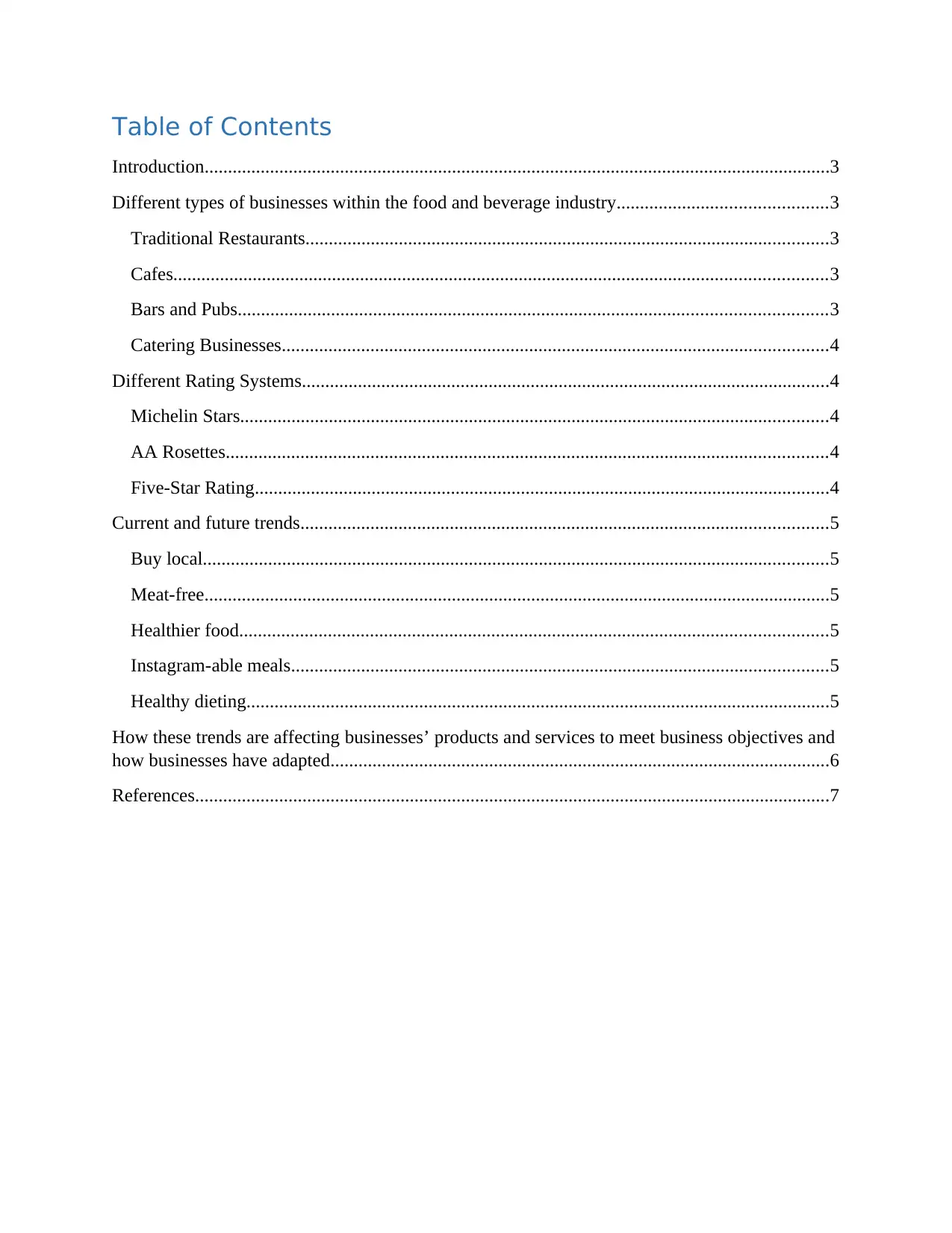
Table of Contents
Introduction......................................................................................................................................3
Different types of businesses within the food and beverage industry.............................................3
Traditional Restaurants................................................................................................................3
Cafes............................................................................................................................................3
Bars and Pubs..............................................................................................................................3
Catering Businesses.....................................................................................................................4
Different Rating Systems.................................................................................................................4
Michelin Stars..............................................................................................................................4
AA Rosettes.................................................................................................................................4
Five-Star Rating...........................................................................................................................4
Current and future trends.................................................................................................................5
Buy local......................................................................................................................................5
Meat-free......................................................................................................................................5
Healthier food..............................................................................................................................5
Instagram-able meals...................................................................................................................5
Healthy dieting.............................................................................................................................5
How these trends are affecting businesses’ products and services to meet business objectives and
how businesses have adapted...........................................................................................................6
References........................................................................................................................................7
Introduction......................................................................................................................................3
Different types of businesses within the food and beverage industry.............................................3
Traditional Restaurants................................................................................................................3
Cafes............................................................................................................................................3
Bars and Pubs..............................................................................................................................3
Catering Businesses.....................................................................................................................4
Different Rating Systems.................................................................................................................4
Michelin Stars..............................................................................................................................4
AA Rosettes.................................................................................................................................4
Five-Star Rating...........................................................................................................................4
Current and future trends.................................................................................................................5
Buy local......................................................................................................................................5
Meat-free......................................................................................................................................5
Healthier food..............................................................................................................................5
Instagram-able meals...................................................................................................................5
Healthy dieting.............................................................................................................................5
How these trends are affecting businesses’ products and services to meet business objectives and
how businesses have adapted...........................................................................................................6
References........................................................................................................................................7
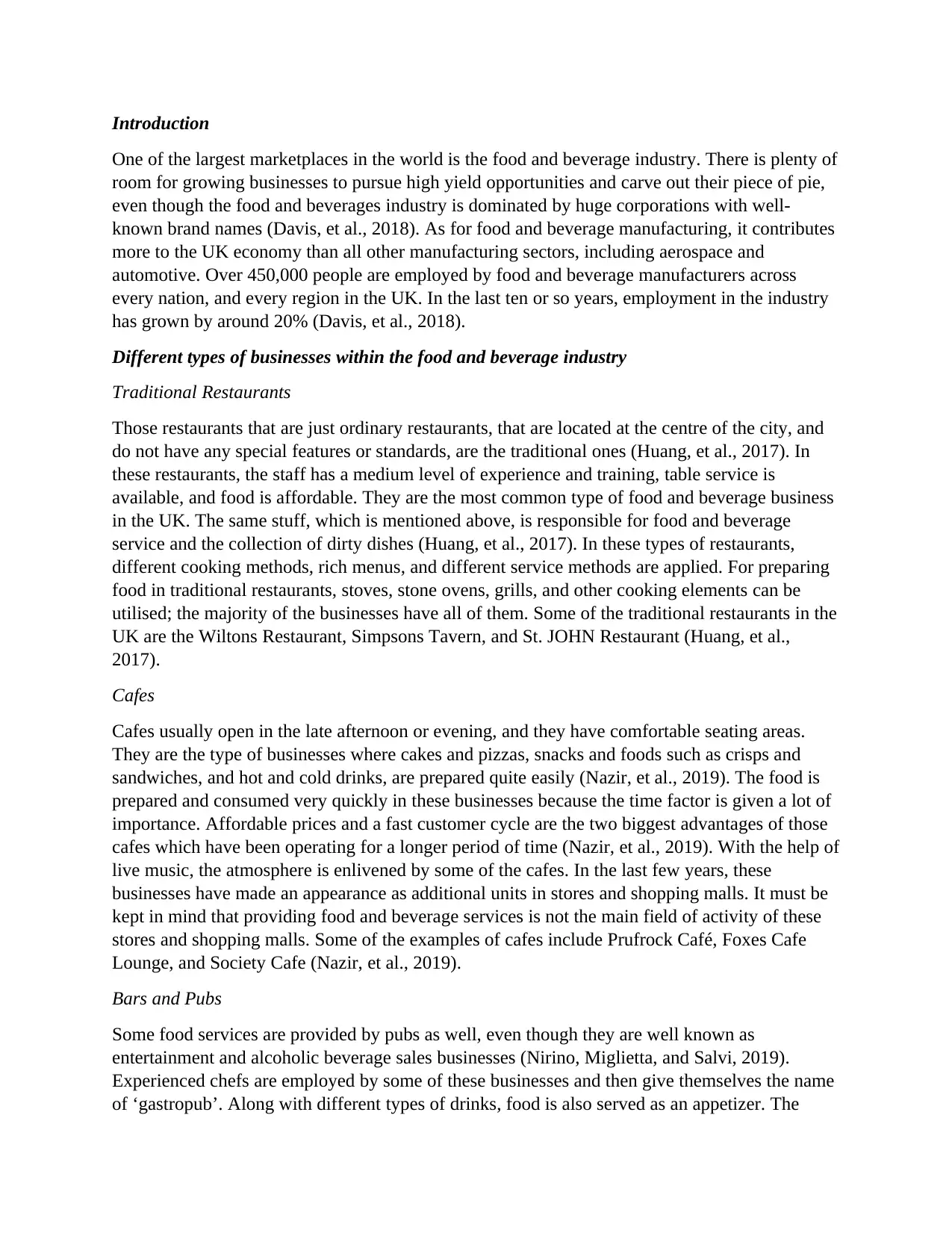
Introduction
One of the largest marketplaces in the world is the food and beverage industry. There is plenty of
room for growing businesses to pursue high yield opportunities and carve out their piece of pie,
even though the food and beverages industry is dominated by huge corporations with well-
known brand names (Davis, et al., 2018). As for food and beverage manufacturing, it contributes
more to the UK economy than all other manufacturing sectors, including aerospace and
automotive. Over 450,000 people are employed by food and beverage manufacturers across
every nation, and every region in the UK. In the last ten or so years, employment in the industry
has grown by around 20% (Davis, et al., 2018).
Different types of businesses within the food and beverage industry
Traditional Restaurants
Those restaurants that are just ordinary restaurants, that are located at the centre of the city, and
do not have any special features or standards, are the traditional ones (Huang, et al., 2017). In
these restaurants, the staff has a medium level of experience and training, table service is
available, and food is affordable. They are the most common type of food and beverage business
in the UK. The same stuff, which is mentioned above, is responsible for food and beverage
service and the collection of dirty dishes (Huang, et al., 2017). In these types of restaurants,
different cooking methods, rich menus, and different service methods are applied. For preparing
food in traditional restaurants, stoves, stone ovens, grills, and other cooking elements can be
utilised; the majority of the businesses have all of them. Some of the traditional restaurants in the
UK are the Wiltons Restaurant, Simpsons Tavern, and St. JOHN Restaurant (Huang, et al.,
2017).
Cafes
Cafes usually open in the late afternoon or evening, and they have comfortable seating areas.
They are the type of businesses where cakes and pizzas, snacks and foods such as crisps and
sandwiches, and hot and cold drinks, are prepared quite easily (Nazir, et al., 2019). The food is
prepared and consumed very quickly in these businesses because the time factor is given a lot of
importance. Affordable prices and a fast customer cycle are the two biggest advantages of those
cafes which have been operating for a longer period of time (Nazir, et al., 2019). With the help of
live music, the atmosphere is enlivened by some of the cafes. In the last few years, these
businesses have made an appearance as additional units in stores and shopping malls. It must be
kept in mind that providing food and beverage services is not the main field of activity of these
stores and shopping malls. Some of the examples of cafes include Prufrock Café, Foxes Cafe
Lounge, and Society Cafe (Nazir, et al., 2019).
Bars and Pubs
Some food services are provided by pubs as well, even though they are well known as
entertainment and alcoholic beverage sales businesses (Nirino, Miglietta, and Salvi, 2019).
Experienced chefs are employed by some of these businesses and then give themselves the name
of ‘gastropub’. Along with different types of drinks, food is also served as an appetizer. The
One of the largest marketplaces in the world is the food and beverage industry. There is plenty of
room for growing businesses to pursue high yield opportunities and carve out their piece of pie,
even though the food and beverages industry is dominated by huge corporations with well-
known brand names (Davis, et al., 2018). As for food and beverage manufacturing, it contributes
more to the UK economy than all other manufacturing sectors, including aerospace and
automotive. Over 450,000 people are employed by food and beverage manufacturers across
every nation, and every region in the UK. In the last ten or so years, employment in the industry
has grown by around 20% (Davis, et al., 2018).
Different types of businesses within the food and beverage industry
Traditional Restaurants
Those restaurants that are just ordinary restaurants, that are located at the centre of the city, and
do not have any special features or standards, are the traditional ones (Huang, et al., 2017). In
these restaurants, the staff has a medium level of experience and training, table service is
available, and food is affordable. They are the most common type of food and beverage business
in the UK. The same stuff, which is mentioned above, is responsible for food and beverage
service and the collection of dirty dishes (Huang, et al., 2017). In these types of restaurants,
different cooking methods, rich menus, and different service methods are applied. For preparing
food in traditional restaurants, stoves, stone ovens, grills, and other cooking elements can be
utilised; the majority of the businesses have all of them. Some of the traditional restaurants in the
UK are the Wiltons Restaurant, Simpsons Tavern, and St. JOHN Restaurant (Huang, et al.,
2017).
Cafes
Cafes usually open in the late afternoon or evening, and they have comfortable seating areas.
They are the type of businesses where cakes and pizzas, snacks and foods such as crisps and
sandwiches, and hot and cold drinks, are prepared quite easily (Nazir, et al., 2019). The food is
prepared and consumed very quickly in these businesses because the time factor is given a lot of
importance. Affordable prices and a fast customer cycle are the two biggest advantages of those
cafes which have been operating for a longer period of time (Nazir, et al., 2019). With the help of
live music, the atmosphere is enlivened by some of the cafes. In the last few years, these
businesses have made an appearance as additional units in stores and shopping malls. It must be
kept in mind that providing food and beverage services is not the main field of activity of these
stores and shopping malls. Some of the examples of cafes include Prufrock Café, Foxes Cafe
Lounge, and Society Cafe (Nazir, et al., 2019).
Bars and Pubs
Some food services are provided by pubs as well, even though they are well known as
entertainment and alcoholic beverage sales businesses (Nirino, Miglietta, and Salvi, 2019).
Experienced chefs are employed by some of these businesses and then give themselves the name
of ‘gastropub’. Along with different types of drinks, food is also served as an appetizer. The
⊘ This is a preview!⊘
Do you want full access?
Subscribe today to unlock all pages.

Trusted by 1+ million students worldwide
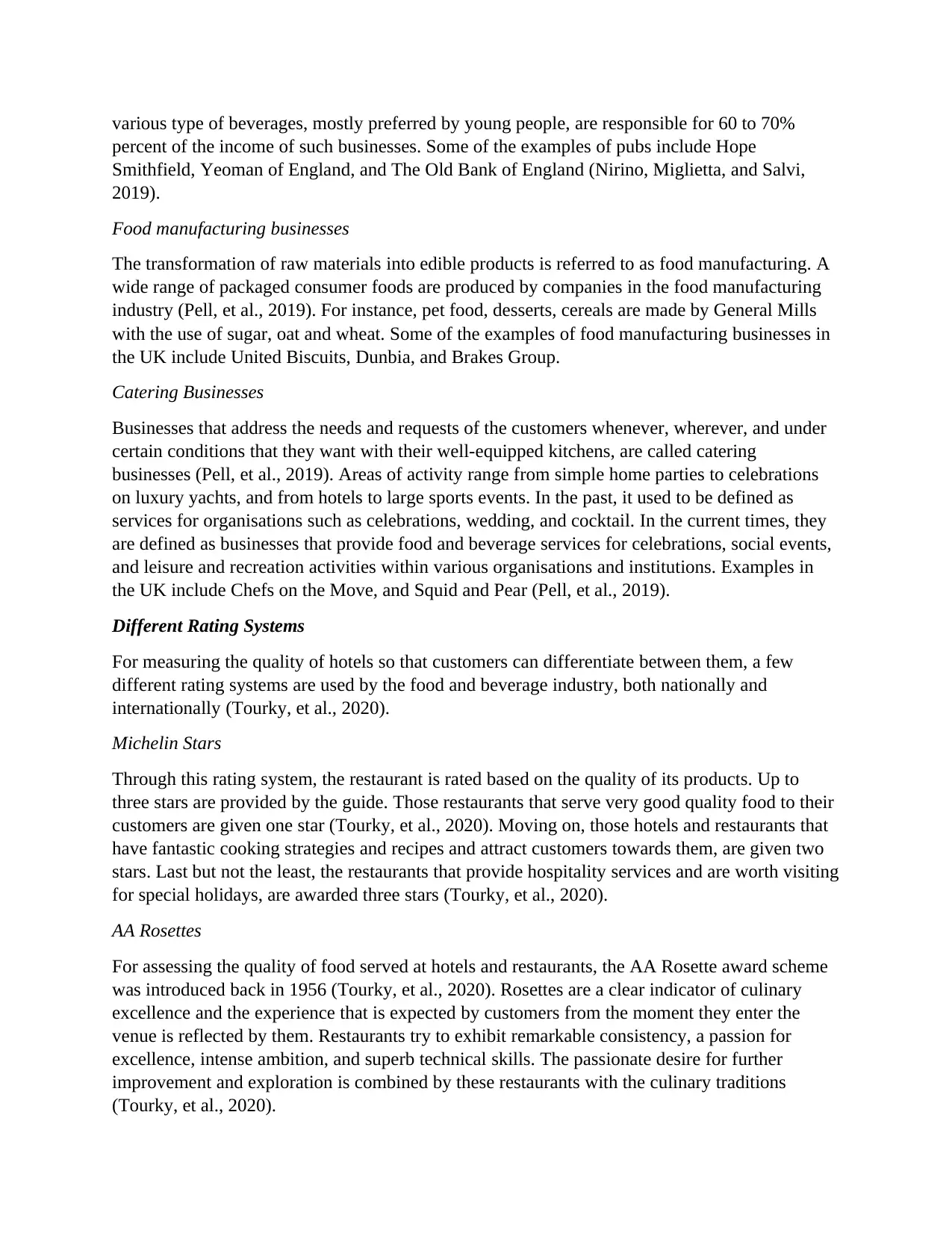
various type of beverages, mostly preferred by young people, are responsible for 60 to 70%
percent of the income of such businesses. Some of the examples of pubs include Hope
Smithfield, Yeoman of England, and The Old Bank of England (Nirino, Miglietta, and Salvi,
2019).
Food manufacturing businesses
The transformation of raw materials into edible products is referred to as food manufacturing. A
wide range of packaged consumer foods are produced by companies in the food manufacturing
industry (Pell, et al., 2019). For instance, pet food, desserts, cereals are made by General Mills
with the use of sugar, oat and wheat. Some of the examples of food manufacturing businesses in
the UK include United Biscuits, Dunbia, and Brakes Group.
Catering Businesses
Businesses that address the needs and requests of the customers whenever, wherever, and under
certain conditions that they want with their well-equipped kitchens, are called catering
businesses (Pell, et al., 2019). Areas of activity range from simple home parties to celebrations
on luxury yachts, and from hotels to large sports events. In the past, it used to be defined as
services for organisations such as celebrations, wedding, and cocktail. In the current times, they
are defined as businesses that provide food and beverage services for celebrations, social events,
and leisure and recreation activities within various organisations and institutions. Examples in
the UK include Chefs on the Move, and Squid and Pear (Pell, et al., 2019).
Different Rating Systems
For measuring the quality of hotels so that customers can differentiate between them, a few
different rating systems are used by the food and beverage industry, both nationally and
internationally (Tourky, et al., 2020).
Michelin Stars
Through this rating system, the restaurant is rated based on the quality of its products. Up to
three stars are provided by the guide. Those restaurants that serve very good quality food to their
customers are given one star (Tourky, et al., 2020). Moving on, those hotels and restaurants that
have fantastic cooking strategies and recipes and attract customers towards them, are given two
stars. Last but not the least, the restaurants that provide hospitality services and are worth visiting
for special holidays, are awarded three stars (Tourky, et al., 2020).
AA Rosettes
For assessing the quality of food served at hotels and restaurants, the AA Rosette award scheme
was introduced back in 1956 (Tourky, et al., 2020). Rosettes are a clear indicator of culinary
excellence and the experience that is expected by customers from the moment they enter the
venue is reflected by them. Restaurants try to exhibit remarkable consistency, a passion for
excellence, intense ambition, and superb technical skills. The passionate desire for further
improvement and exploration is combined by these restaurants with the culinary traditions
(Tourky, et al., 2020).
percent of the income of such businesses. Some of the examples of pubs include Hope
Smithfield, Yeoman of England, and The Old Bank of England (Nirino, Miglietta, and Salvi,
2019).
Food manufacturing businesses
The transformation of raw materials into edible products is referred to as food manufacturing. A
wide range of packaged consumer foods are produced by companies in the food manufacturing
industry (Pell, et al., 2019). For instance, pet food, desserts, cereals are made by General Mills
with the use of sugar, oat and wheat. Some of the examples of food manufacturing businesses in
the UK include United Biscuits, Dunbia, and Brakes Group.
Catering Businesses
Businesses that address the needs and requests of the customers whenever, wherever, and under
certain conditions that they want with their well-equipped kitchens, are called catering
businesses (Pell, et al., 2019). Areas of activity range from simple home parties to celebrations
on luxury yachts, and from hotels to large sports events. In the past, it used to be defined as
services for organisations such as celebrations, wedding, and cocktail. In the current times, they
are defined as businesses that provide food and beverage services for celebrations, social events,
and leisure and recreation activities within various organisations and institutions. Examples in
the UK include Chefs on the Move, and Squid and Pear (Pell, et al., 2019).
Different Rating Systems
For measuring the quality of hotels so that customers can differentiate between them, a few
different rating systems are used by the food and beverage industry, both nationally and
internationally (Tourky, et al., 2020).
Michelin Stars
Through this rating system, the restaurant is rated based on the quality of its products. Up to
three stars are provided by the guide. Those restaurants that serve very good quality food to their
customers are given one star (Tourky, et al., 2020). Moving on, those hotels and restaurants that
have fantastic cooking strategies and recipes and attract customers towards them, are given two
stars. Last but not the least, the restaurants that provide hospitality services and are worth visiting
for special holidays, are awarded three stars (Tourky, et al., 2020).
AA Rosettes
For assessing the quality of food served at hotels and restaurants, the AA Rosette award scheme
was introduced back in 1956 (Tourky, et al., 2020). Rosettes are a clear indicator of culinary
excellence and the experience that is expected by customers from the moment they enter the
venue is reflected by them. Restaurants try to exhibit remarkable consistency, a passion for
excellence, intense ambition, and superb technical skills. The passionate desire for further
improvement and exploration is combined by these restaurants with the culinary traditions
(Tourky, et al., 2020).
Paraphrase This Document
Need a fresh take? Get an instant paraphrase of this document with our AI Paraphraser
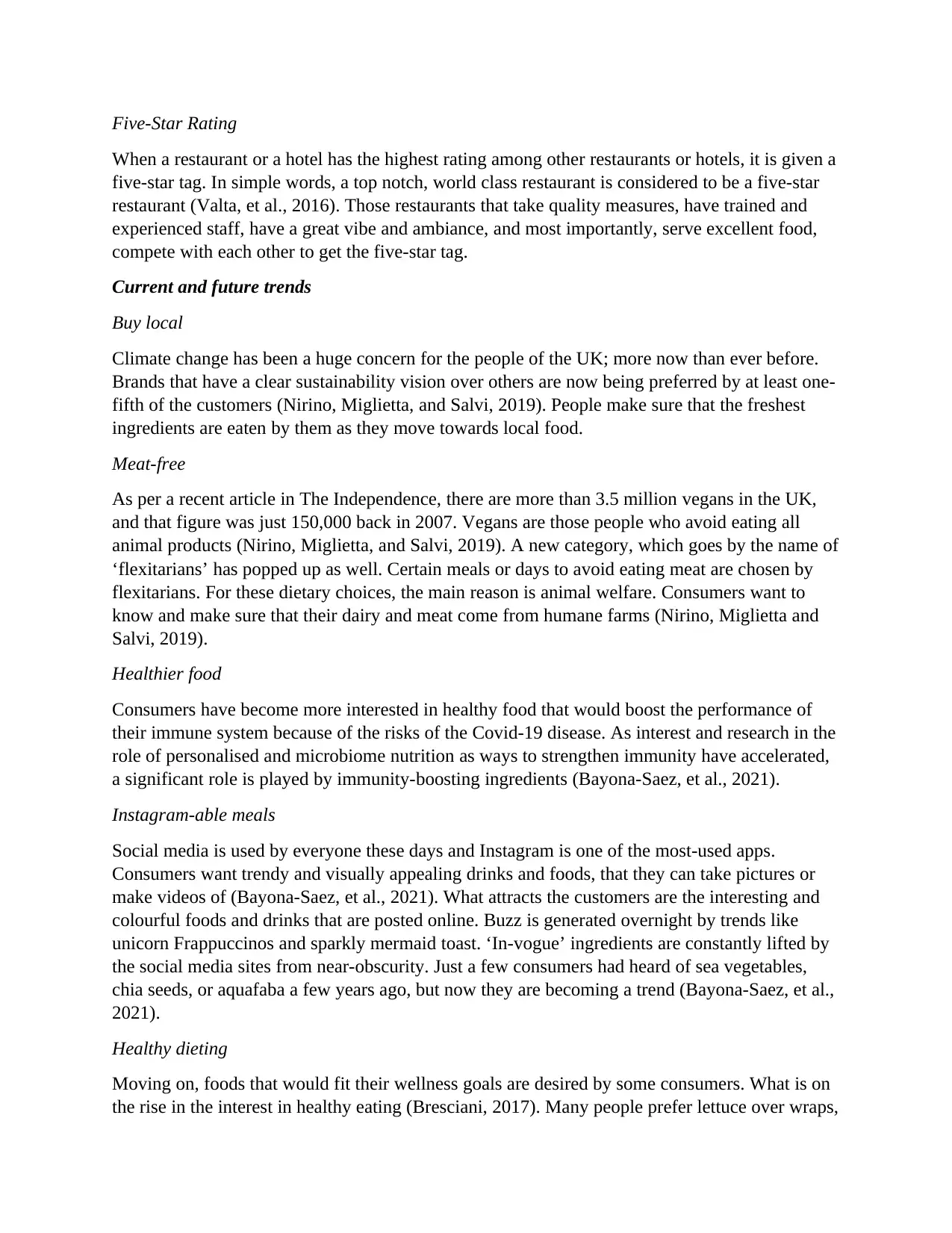
Five-Star Rating
When a restaurant or a hotel has the highest rating among other restaurants or hotels, it is given a
five-star tag. In simple words, a top notch, world class restaurant is considered to be a five-star
restaurant (Valta, et al., 2016). Those restaurants that take quality measures, have trained and
experienced staff, have a great vibe and ambiance, and most importantly, serve excellent food,
compete with each other to get the five-star tag.
Current and future trends
Buy local
Climate change has been a huge concern for the people of the UK; more now than ever before.
Brands that have a clear sustainability vision over others are now being preferred by at least one-
fifth of the customers (Nirino, Miglietta, and Salvi, 2019). People make sure that the freshest
ingredients are eaten by them as they move towards local food.
Meat-free
As per a recent article in The Independence, there are more than 3.5 million vegans in the UK,
and that figure was just 150,000 back in 2007. Vegans are those people who avoid eating all
animal products (Nirino, Miglietta, and Salvi, 2019). A new category, which goes by the name of
‘flexitarians’ has popped up as well. Certain meals or days to avoid eating meat are chosen by
flexitarians. For these dietary choices, the main reason is animal welfare. Consumers want to
know and make sure that their dairy and meat come from humane farms (Nirino, Miglietta and
Salvi, 2019).
Healthier food
Consumers have become more interested in healthy food that would boost the performance of
their immune system because of the risks of the Covid-19 disease. As interest and research in the
role of personalised and microbiome nutrition as ways to strengthen immunity have accelerated,
a significant role is played by immunity-boosting ingredients (Bayona-Saez, et al., 2021).
Instagram-able meals
Social media is used by everyone these days and Instagram is one of the most-used apps.
Consumers want trendy and visually appealing drinks and foods, that they can take pictures or
make videos of (Bayona-Saez, et al., 2021). What attracts the customers are the interesting and
colourful foods and drinks that are posted online. Buzz is generated overnight by trends like
unicorn Frappuccinos and sparkly mermaid toast. ‘In-vogue’ ingredients are constantly lifted by
the social media sites from near-obscurity. Just a few consumers had heard of sea vegetables,
chia seeds, or aquafaba a few years ago, but now they are becoming a trend (Bayona-Saez, et al.,
2021).
Healthy dieting
Moving on, foods that would fit their wellness goals are desired by some consumers. What is on
the rise in the interest in healthy eating (Bresciani, 2017). Many people prefer lettuce over wraps,
When a restaurant or a hotel has the highest rating among other restaurants or hotels, it is given a
five-star tag. In simple words, a top notch, world class restaurant is considered to be a five-star
restaurant (Valta, et al., 2016). Those restaurants that take quality measures, have trained and
experienced staff, have a great vibe and ambiance, and most importantly, serve excellent food,
compete with each other to get the five-star tag.
Current and future trends
Buy local
Climate change has been a huge concern for the people of the UK; more now than ever before.
Brands that have a clear sustainability vision over others are now being preferred by at least one-
fifth of the customers (Nirino, Miglietta, and Salvi, 2019). People make sure that the freshest
ingredients are eaten by them as they move towards local food.
Meat-free
As per a recent article in The Independence, there are more than 3.5 million vegans in the UK,
and that figure was just 150,000 back in 2007. Vegans are those people who avoid eating all
animal products (Nirino, Miglietta, and Salvi, 2019). A new category, which goes by the name of
‘flexitarians’ has popped up as well. Certain meals or days to avoid eating meat are chosen by
flexitarians. For these dietary choices, the main reason is animal welfare. Consumers want to
know and make sure that their dairy and meat come from humane farms (Nirino, Miglietta and
Salvi, 2019).
Healthier food
Consumers have become more interested in healthy food that would boost the performance of
their immune system because of the risks of the Covid-19 disease. As interest and research in the
role of personalised and microbiome nutrition as ways to strengthen immunity have accelerated,
a significant role is played by immunity-boosting ingredients (Bayona-Saez, et al., 2021).
Instagram-able meals
Social media is used by everyone these days and Instagram is one of the most-used apps.
Consumers want trendy and visually appealing drinks and foods, that they can take pictures or
make videos of (Bayona-Saez, et al., 2021). What attracts the customers are the interesting and
colourful foods and drinks that are posted online. Buzz is generated overnight by trends like
unicorn Frappuccinos and sparkly mermaid toast. ‘In-vogue’ ingredients are constantly lifted by
the social media sites from near-obscurity. Just a few consumers had heard of sea vegetables,
chia seeds, or aquafaba a few years ago, but now they are becoming a trend (Bayona-Saez, et al.,
2021).
Healthy dieting
Moving on, foods that would fit their wellness goals are desired by some consumers. What is on
the rise in the interest in healthy eating (Bresciani, 2017). Many people prefer lettuce over wraps,
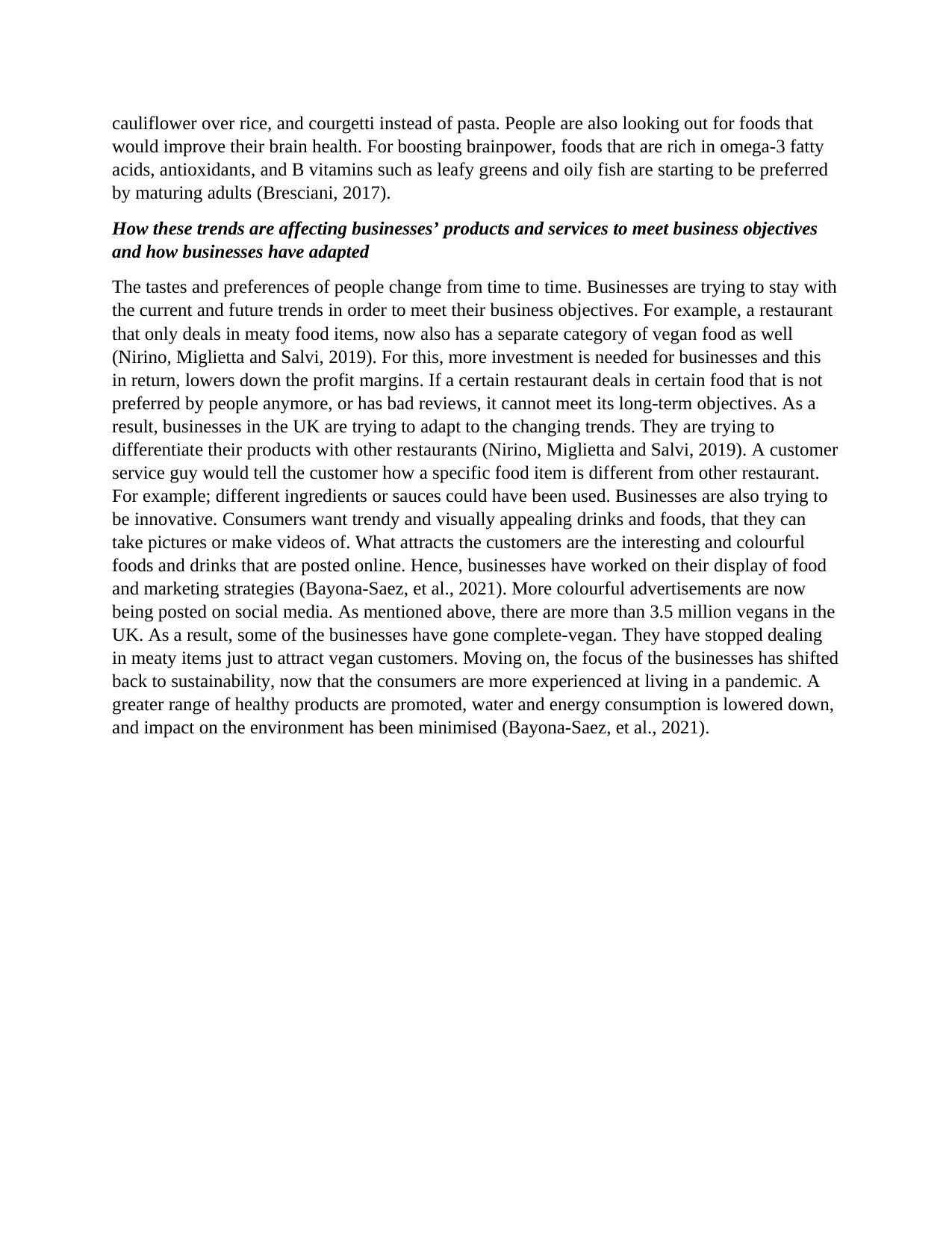
cauliflower over rice, and courgetti instead of pasta. People are also looking out for foods that
would improve their brain health. For boosting brainpower, foods that are rich in omega-3 fatty
acids, antioxidants, and B vitamins such as leafy greens and oily fish are starting to be preferred
by maturing adults (Bresciani, 2017).
How these trends are affecting businesses’ products and services to meet business objectives
and how businesses have adapted
The tastes and preferences of people change from time to time. Businesses are trying to stay with
the current and future trends in order to meet their business objectives. For example, a restaurant
that only deals in meaty food items, now also has a separate category of vegan food as well
(Nirino, Miglietta and Salvi, 2019). For this, more investment is needed for businesses and this
in return, lowers down the profit margins. If a certain restaurant deals in certain food that is not
preferred by people anymore, or has bad reviews, it cannot meet its long-term objectives. As a
result, businesses in the UK are trying to adapt to the changing trends. They are trying to
differentiate their products with other restaurants (Nirino, Miglietta and Salvi, 2019). A customer
service guy would tell the customer how a specific food item is different from other restaurant.
For example; different ingredients or sauces could have been used. Businesses are also trying to
be innovative. Consumers want trendy and visually appealing drinks and foods, that they can
take pictures or make videos of. What attracts the customers are the interesting and colourful
foods and drinks that are posted online. Hence, businesses have worked on their display of food
and marketing strategies (Bayona-Saez, et al., 2021). More colourful advertisements are now
being posted on social media. As mentioned above, there are more than 3.5 million vegans in the
UK. As a result, some of the businesses have gone complete-vegan. They have stopped dealing
in meaty items just to attract vegan customers. Moving on, the focus of the businesses has shifted
back to sustainability, now that the consumers are more experienced at living in a pandemic. A
greater range of healthy products are promoted, water and energy consumption is lowered down,
and impact on the environment has been minimised (Bayona-Saez, et al., 2021).
would improve their brain health. For boosting brainpower, foods that are rich in omega-3 fatty
acids, antioxidants, and B vitamins such as leafy greens and oily fish are starting to be preferred
by maturing adults (Bresciani, 2017).
How these trends are affecting businesses’ products and services to meet business objectives
and how businesses have adapted
The tastes and preferences of people change from time to time. Businesses are trying to stay with
the current and future trends in order to meet their business objectives. For example, a restaurant
that only deals in meaty food items, now also has a separate category of vegan food as well
(Nirino, Miglietta and Salvi, 2019). For this, more investment is needed for businesses and this
in return, lowers down the profit margins. If a certain restaurant deals in certain food that is not
preferred by people anymore, or has bad reviews, it cannot meet its long-term objectives. As a
result, businesses in the UK are trying to adapt to the changing trends. They are trying to
differentiate their products with other restaurants (Nirino, Miglietta and Salvi, 2019). A customer
service guy would tell the customer how a specific food item is different from other restaurant.
For example; different ingredients or sauces could have been used. Businesses are also trying to
be innovative. Consumers want trendy and visually appealing drinks and foods, that they can
take pictures or make videos of. What attracts the customers are the interesting and colourful
foods and drinks that are posted online. Hence, businesses have worked on their display of food
and marketing strategies (Bayona-Saez, et al., 2021). More colourful advertisements are now
being posted on social media. As mentioned above, there are more than 3.5 million vegans in the
UK. As a result, some of the businesses have gone complete-vegan. They have stopped dealing
in meaty items just to attract vegan customers. Moving on, the focus of the businesses has shifted
back to sustainability, now that the consumers are more experienced at living in a pandemic. A
greater range of healthy products are promoted, water and energy consumption is lowered down,
and impact on the environment has been minimised (Bayona-Saez, et al., 2021).
⊘ This is a preview!⊘
Do you want full access?
Subscribe today to unlock all pages.

Trusted by 1+ million students worldwide
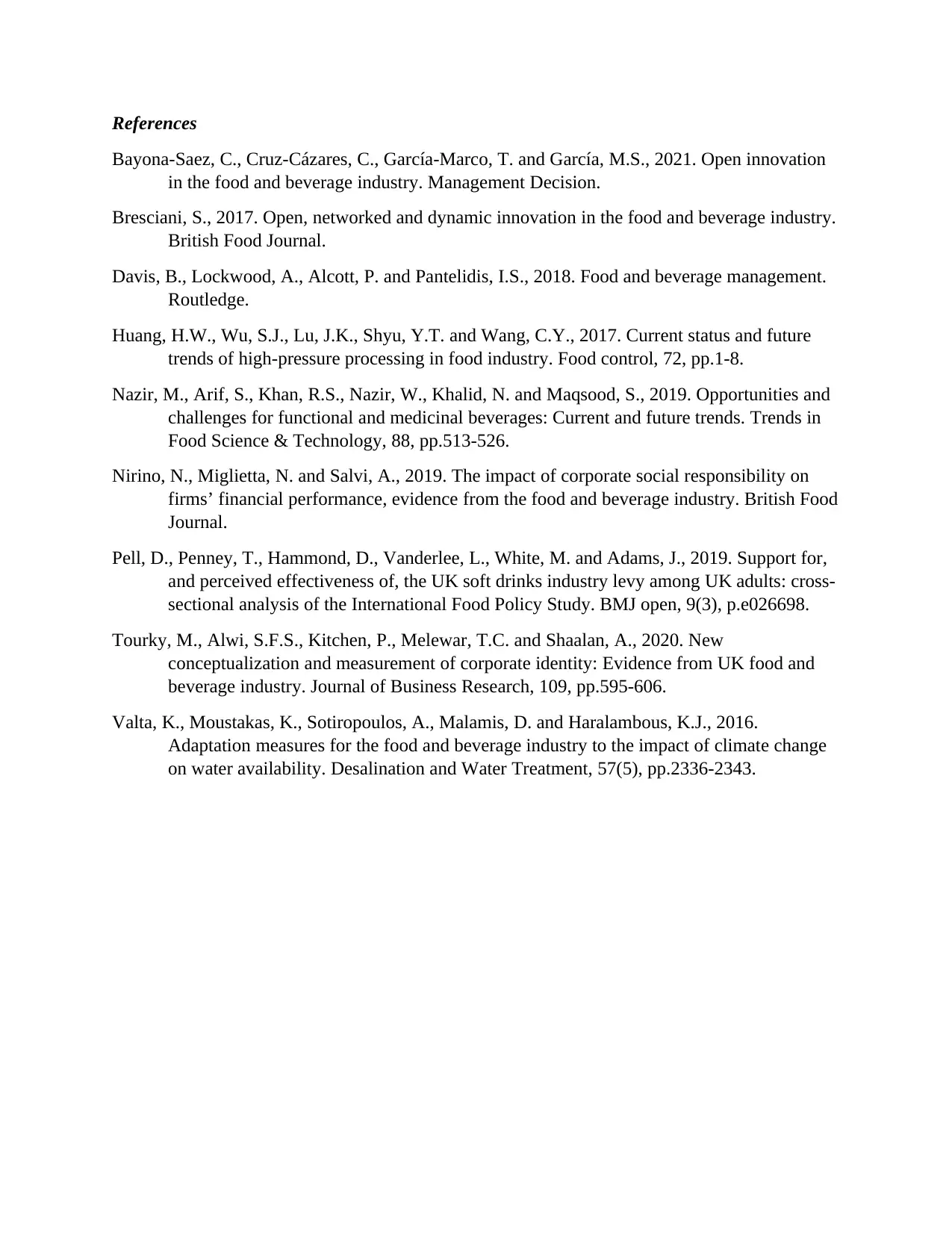
References
Bayona-Saez, C., Cruz-Cázares, C., García-Marco, T. and García, M.S., 2021. Open innovation
in the food and beverage industry. Management Decision.
Bresciani, S., 2017. Open, networked and dynamic innovation in the food and beverage industry.
British Food Journal.
Davis, B., Lockwood, A., Alcott, P. and Pantelidis, I.S., 2018. Food and beverage management.
Routledge.
Huang, H.W., Wu, S.J., Lu, J.K., Shyu, Y.T. and Wang, C.Y., 2017. Current status and future
trends of high-pressure processing in food industry. Food control, 72, pp.1-8.
Nazir, M., Arif, S., Khan, R.S., Nazir, W., Khalid, N. and Maqsood, S., 2019. Opportunities and
challenges for functional and medicinal beverages: Current and future trends. Trends in
Food Science & Technology, 88, pp.513-526.
Nirino, N., Miglietta, N. and Salvi, A., 2019. The impact of corporate social responsibility on
firms’ financial performance, evidence from the food and beverage industry. British Food
Journal.
Pell, D., Penney, T., Hammond, D., Vanderlee, L., White, M. and Adams, J., 2019. Support for,
and perceived effectiveness of, the UK soft drinks industry levy among UK adults: cross-
sectional analysis of the International Food Policy Study. BMJ open, 9(3), p.e026698.
Tourky, M., Alwi, S.F.S., Kitchen, P., Melewar, T.C. and Shaalan, A., 2020. New
conceptualization and measurement of corporate identity: Evidence from UK food and
beverage industry. Journal of Business Research, 109, pp.595-606.
Valta, K., Moustakas, K., Sotiropoulos, A., Malamis, D. and Haralambous, K.J., 2016.
Adaptation measures for the food and beverage industry to the impact of climate change
on water availability. Desalination and Water Treatment, 57(5), pp.2336-2343.
Bayona-Saez, C., Cruz-Cázares, C., García-Marco, T. and García, M.S., 2021. Open innovation
in the food and beverage industry. Management Decision.
Bresciani, S., 2017. Open, networked and dynamic innovation in the food and beverage industry.
British Food Journal.
Davis, B., Lockwood, A., Alcott, P. and Pantelidis, I.S., 2018. Food and beverage management.
Routledge.
Huang, H.W., Wu, S.J., Lu, J.K., Shyu, Y.T. and Wang, C.Y., 2017. Current status and future
trends of high-pressure processing in food industry. Food control, 72, pp.1-8.
Nazir, M., Arif, S., Khan, R.S., Nazir, W., Khalid, N. and Maqsood, S., 2019. Opportunities and
challenges for functional and medicinal beverages: Current and future trends. Trends in
Food Science & Technology, 88, pp.513-526.
Nirino, N., Miglietta, N. and Salvi, A., 2019. The impact of corporate social responsibility on
firms’ financial performance, evidence from the food and beverage industry. British Food
Journal.
Pell, D., Penney, T., Hammond, D., Vanderlee, L., White, M. and Adams, J., 2019. Support for,
and perceived effectiveness of, the UK soft drinks industry levy among UK adults: cross-
sectional analysis of the International Food Policy Study. BMJ open, 9(3), p.e026698.
Tourky, M., Alwi, S.F.S., Kitchen, P., Melewar, T.C. and Shaalan, A., 2020. New
conceptualization and measurement of corporate identity: Evidence from UK food and
beverage industry. Journal of Business Research, 109, pp.595-606.
Valta, K., Moustakas, K., Sotiropoulos, A., Malamis, D. and Haralambous, K.J., 2016.
Adaptation measures for the food and beverage industry to the impact of climate change
on water availability. Desalination and Water Treatment, 57(5), pp.2336-2343.
1 out of 7
Related Documents
Your All-in-One AI-Powered Toolkit for Academic Success.
+13062052269
info@desklib.com
Available 24*7 on WhatsApp / Email
![[object Object]](/_next/static/media/star-bottom.7253800d.svg)
Unlock your academic potential
Copyright © 2020–2025 A2Z Services. All Rights Reserved. Developed and managed by ZUCOL.



